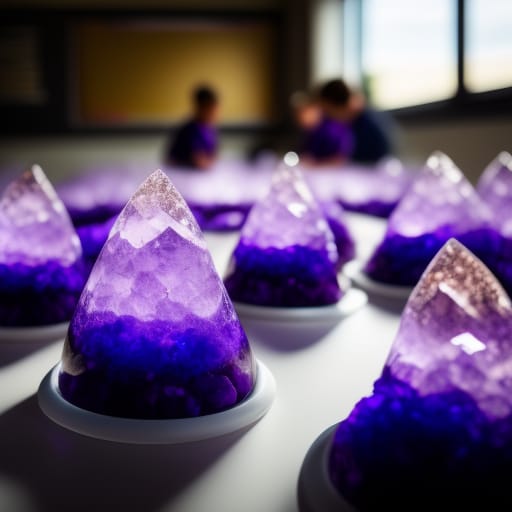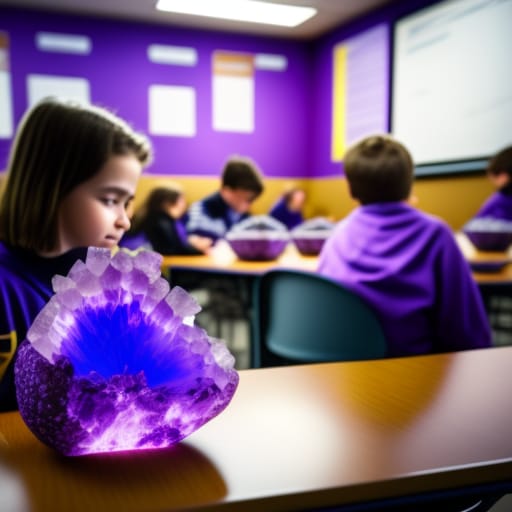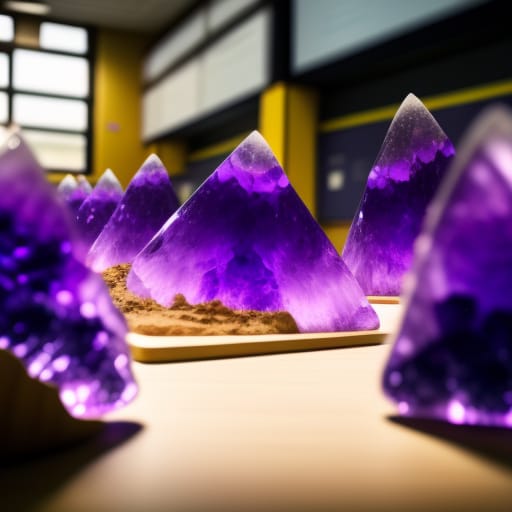Crystal growing is a fascinating science experiment that allows children and adults to observe the formation and growth of crystals. It’s an engaging hands-on activity that teaches about chemistry, physics, geometry, and mineralogy. This beginner’s guide will explore the world of crystal growing, from the best books and kits to get started to advanced references for crystal growing enthusiasts.

An Introduction to Crystal Growing
Crystal growing, also known as crystallization or recrystallization, is the process of forming a solid crystalline structure from a solution. As the solution evaporates, dissolved particles start joining together in an orderly, repeating pattern known as a crystal lattice. These particles attach themselves to a seed crystal, layer by layer, slowly growing into larger, visible crystals.
Crystal growing allows us to observe some key scientific concepts in action:
- States of matter – seeing the transition from liquid solution to solid crystal
- Chemistry – visualizing chemical structures and atomic bonding
- Geometry – examining the angles, faces, shapes, and patterns of crystals
- Mineralogy – studying the composition and properties of different mineral crystals
- Nucleation – watching the initiation of a crystalline structure around a seed crystal
- Precipitation – looking at particles precipitating out of the solution
- Symmetry – observing the symmetrical, repeating structures of crystals
- Polymorphism – comparing how crystals of the same compound can form different structures
Overall, crystal growing is a fun, inexpensive, and safe way to learn about science through direct experience and observation. It’s ideal for children and students but can be enjoyed at any age.
The Benefits of Crystal Growing for Science Education
Crystal growing is an ideal science experiment for children of all ages. Here are some of the main benefits it provides:
- Hands-on learning: Crystal growing allows students to actively participate in the scientific process instead of just reading about it.
- Real-world applications: The concepts learned, like chemistry and geometry, are directly applicable to real-world science.
- Instant gratification: Students can enjoy an exciting “Wow!” moment when they uncover the crystals they formed.
- Simple setup: Basic crystal growing experiments require minimal equipment and can be done in the classroom, at home, etc.
- Visual learning: The visual nature of observing crystal growth appeals to visual learners and helps concretize abstract concepts.
- Safe exploration: Crystal growing introduces children to scientific concepts very safely, unlike more dangerous lab experiments.
- Problem-solving skills: Students learn how changing conditions affect crystal growth, teaching critical thinking.
- STEM skills: Crystal growing promotes skills across Science, Technology, Engineering, and Math.
Overall, crystal growing is an engaging way to develop a love of science and an understanding of key scientific principles at an early age. The hands-on learning style also helps children better retain knowledge.
Types of Crystal Growing Kits
Crystal growing kits are hands-on science experiment kits designed to help both children and adults easily grow different types of crystals at home. Here are some of the most common types of crystal growing kits:
Salt Crystal Kits: These kits use table salt dissolved in water to grow salt crystals, often on included string or rocks. Great inexpensive introduction to crystal growing.
Alum Crystal Kits: Alum powder or chunks are used to grow large, clear alum crystals, which can form octahedral, cubic or dodecahedral shapes.
Geode Kits: Grow your own geode filled with colorful crystals, often made of borax, alum or Epsom salts. May need to crack open with hammer afterwards.
Gemstone Kits: Grow crystals made of semi-precious stones like amethyst, emerald, ruby or sapphire. More expensive but great for older kids.
Mineral Crystals Kits: Grow naturally occurring mineral crystals, like copper sulfate, that have unique properties and chemistry.
Classroom Kits: Designed for teachers, with enough materials for a whole class to participate in crystal growing experiments.
When selecting a crystal growing kit, factors like age appropriateness, types of crystals, educational value, cost, etc. should be considered. Read on for recommendations of the best kits.

Top 5 Crystal Growing Kits for Beginners
Here are 5 highly-rated crystal growing kits that are perfect for introducing beginners to the fascinating world of crystal formation:
1. 4M Crystal Growing Kit
This is one of the best-selling crystal growing kits on Amazon, with over 5,000 reviews. It allows you to grow six different types of crystals, including copper sulfate, potassium alum, and sodium chloride. The compact kit is great for kids but fun for adults too.
Pros
- Grow 6 crystal types
- Very clear instructions
- All materials included
- Child safe
Cons
- Some crystals grow better than others
- Takes 1-2 weeks for full crystal growth
Price: $22.95
2. SmartLab Toys Crystal Mining Kit
Excavate real amethyst, citrine, and calcite crystals with this award-winning STEM kit. Includes display stand to show off your crystals. Great for ages 8+.
Pros
- Grow 3 crystal types
- Kids can mine their own crystals
- Display stand to show crystals
- Fun educational activity
Cons
- Not as many experiments
- Higher price tag
Price: $34.95
3. National Geographic Break Open 10 Geodes
This kit lets you break open 10 real geodes to uncover amethyst, agate, and quartz crystal formations. Includes learning guide and display stands.
Pros
- Real geodes to break open
- 10 geodes for more experiments
- Fun for kids and adults
- Learn about geodes
Cons
- Need hammer/pliers to open (not included)
- Lesser crystal growing experiments
Price: $26.99
4. Creativity for Kids Grow ‘N Glow Terrarium
Grow fluorescent crystals in this cool terrarium. Just add water to watch crystals sprout before your eyes. Includes black light. Ages 6+
Pros
- Glow-in-the-dark fluorescent crystals
- Easy set-up in a terrarium
- Includes black light
- Fun alternative activity
Cons
- Only 1 type of crystal experiment
- Smaller crystals
Price: $14.99
5. Meland Crystal Growing Lab
This lab kit offers 8 different crystal growing activities allowing you to grow impressive crystals. Ideal for beginners.
Pros
- 8 crystal growing experiments
- Grow huge copper sulfate crystals
- Very affordable price
- Kid-safe materials
Cons
- Simple packaging
- Some crystals grow better than others
Price: $21.99
Recommended Books on Crystal Growing for Beginners
Growing beautiful crystals and discovering their magical world requires some foundational knowledge. Here are some of the best books to turn beginners into crystal growing experts:
The Handy Science Answer Book by the Science Museum of Minnesota
This informative guide answers key questions about crystal growing and minerals in an easy-to-understand Q&A format. Suitable for kids ages 10+ and adults. Covers crystal types, chemical compositions, molecular structures, melting points, and much more. A great reference book.
National Geographic Readers: Rocks and Minerals by Kathleen Weidner Zoehfeld
A fantastic introductory book on rocks and minerals for kids ages 4-8. Teaches identification and properties of different gems, crystals, and rocks. Vibrant images and engaging facts make it fun for young learners.
Smithsonian Handbook: Rocks and Minerals by Chris Pellant
A detailed field guide to identifying rocks and minerals with detailed photographs and descriptions. Suitable for older kids and adults who want to seriously study mineralogy and crystallography.
Crystal & Gem by Robert Cook
A modern, information-packed guide to the world of crystals and gems. Has detailed chapters on crystal systems and structures, chemical compositions, physical properties, suggested experiments, and more. Great for adults.
The Magic School Bus Blows Its Top: A Book About Volcanoes by Joanna Cole
A fun Magic School Bus adventure that introduces kids to concepts about crystals, minerals, and rocks through an engaging story. Better understood after reading more basic books first. Ideal for ages 6-10.

Helpful Resources and References
Beyond books, there are many other informative resources available online and offline to take your crystal growing to the next level:
- YouTube tutorials – Learn techniques from experts through video guides and experiments. Some great channels are NileRed, TheThoughtEmporium, and The Action Lab.
- Science forums – Join hobbyist forums like ScienceMadness to get advice and share experiences with fellow crystal growing enthusiasts.
- Science magazines – Look for crystal growing articles in magazines like Science Illustrated, Science News for Students, and Advanced Science News to learn more about current research.
- University resources – Many university geology or chemistry departments offer pamphlets, online guides, and other resources explaining crystal growing concepts.
- Science museums – Visit museum gift shops or libraries to find crystal growing books and kits for hands-on learning. Some have workshops.
- Local rock and mineral clubs – Join groups on meetup.com or search for clubs through The Mineralogical Society of America to connect with like-minded crystal growers.
The Best Crystals for Beginners to Grow
When starting out with crystal growing, it’s best to begin with types of crystals that are inexpensive, easy to form, and safe to work with. Here are some top recommendations:
Salt (Sodium Chloride)
- Ingredients: Table salt and water
- Easy to grow large cubes and formations
- safe, inexpensive, readily available ingredients
Alum (Potassium Aluminium Sulfate)
- Ingredients: Alum powder/chunks and water
- Grow beautiful translucent crystals with cool geometric shapes
- Long shelf life and very affordable
Borax (Sodium Tetraborate)
- Ingredients: Borax powder and water
- Grow impressive large crystals easily
- Very inexpensive and easily available at grocery stores
Epsom Salts (Magnesium Sulfate)
- Ingredients: Epsom salt and water
- Form interesting crystal structures easily
- Very affordable and easy to find
Sugar or Rock Candy
- Ingredients: Sugar, water, food coloring, flavorings
- Grow edible crystals you can eat when done
- Fun activity for children’s parties or classrooms
How to Grow Your Own Crystals
Growing flawless crystals requires careful experimentation and observation. Follow these basic steps for beginner crystal growing success:
Step 1: Mix your crystal growing solution
- Choose your desired crystal materials like salt, alum, borax, or Epsom salts
- Slowly mix into warm distilled water until fully dissolved
- Use proper ratios for best crystal formation (follow kit or book instructions)
- Add food coloring or speckles for colored crystals if desired
Step 2: Prepare your crystal growing container
- Glass jars, plastic containers, or Petri dishes work well
- Clean thoroughly and dry completely before use
- Tie string or add a stick if growing crystals on a surface
- Optional: place seed crystal to provide a starting point
Step 3: Pour the solution into the container
- Carefully pour the solution into the chosen container
- Fill only halfway to allow room for crystals to grow
- Cover with plastic wrap or lid (small holes optional)
Step 4: Allow crystals to grow
- Place the container in a warm, dark, undisturbed area
- Wait patiently from 1 day to 2 weeks for crystals to form
- Do not disturb or move the container during growth
Step 5: Admire your crystals!
- Carefully uncover your container to view the crystals
- Use tongs to remove crystals – do not touch them directly
- Take photos or observe under a microscope
- Repeat experiments changing variables to grow different shapes
Start growing your own crystals today with these easy steps and expand your science knowledge through direct hands-on learning!
The Future of Crystal Growing
While crystal growing has been popular for centuries, some exciting advances are on the horizon:
New technologies – Tools like holographic microscopy, cryo-electron microscopy, and X-ray diffraction are revealing new insights into crystal formation and atomic structures.
Synthetic crystals – Research into growing synthetic quartz, diamonds, and other crystals has promising industrial applications.
Crystal-based tech – From lasers to semiconductors, our electronics rely on precisely engineered crystals we can continue improving.
Medicinal crystals – Pharmaceutical researchers are exploring how to tailor drug compounds into more effective polymorphic crystals.
Crystal art – Beautiful artistic creations using novel crystal growing techniques indicate a new creative movement.
Space crystals – Zero gravity crystal growth experiments on the International Space Station provide data for purer crystal formations.
AI-guided growth – Machine learning can help model and optimize conditions for flawless crystal growth.
As these innovations continue, crystal growth promises to remain a fascination for scientists and children alike. The magical process of crystals emerging from solutions will no doubt instill a sense of wonder and reveal new realms of scientific discovery.
Conclusion
From chemical bonding to geometry to mineralogy and more, crystal growing provides an ideal introduction to core scientific concepts through hands-on experimentation. This beginner’s guide summarized key areas like:
- The scientific principles behind crystal growing
- Choosing the best crystal growing kits and books
- Helpful online and offline resources and references
- Recommended crystals to start growing as a beginner
- Step-by-step instructions to grow your own crystals
- New frontiers in crystal growing technology and research
The fascinating world of crystal growing is an adventure waiting to be explored. Hopefully, this article provided a roadmap both informative and engaging enough to compel you to start your own crystalline journeys. Growing flawless crystals, whether as an educational experience or a relaxing hobby, is sure to inspire awe at the sublime beauty and perfection of nature.
Frequently Asked Questions
What are the best crystals for beginners to grow?
Some of the best and easiest crystals to start with are salt (sodium chloride), alum (potassium aluminum sulfate), borax (sodium tetraborate), Epsom salts (magnesium sulfate), and rock candy (sugar crystals). These are inexpensive, readily available, and form nice crystal shapes.
What are some good science experiments using crystal growing?
Fun experiments include growing colored crystals by adding food dye, growing crystals around objects like rocks or sticks, growing giant single crystals, growing crystals in different liquids, growing crystals in a terrarium, and even crystallizing biological samples like leaves or insects.
Where can I buy a good crystal growing kit?
Top recommended crystal growing kits for beginners include the 4M Crystal Growing Lab, National Geographic Break Open Geodes, SmartLab Crystal Mining Kit, Creativity for Kids Grow ‘N Glow Terrarium, and Meland Crystal Growing Lab. Look for kits with highly-rated reviews.
What are the important factors when choosing a crystal growing kit?
Key factors are the types of crystals you can grow, number of experiments, quality of materials, ease of use for your skill level, educational value, safety for children, and budget. Carefully read kit descriptions and reviews.
What are some useful references for learning more about crystal growing?
Helpful resources include crystal growing YouTube channels like NileRed and The Action Lab, science forums like ScienceMadness, magazines like Science News for Students, university geology department resources, science museums, and local rock and mineral clubs listed on The Mineralogical Society of America website.